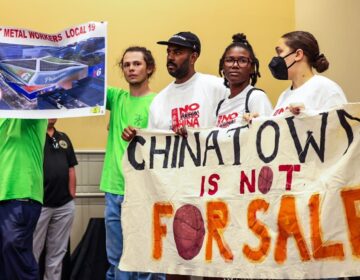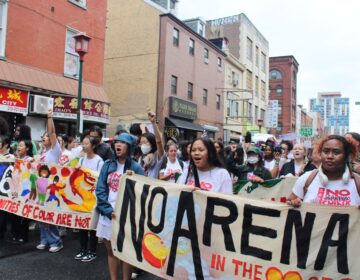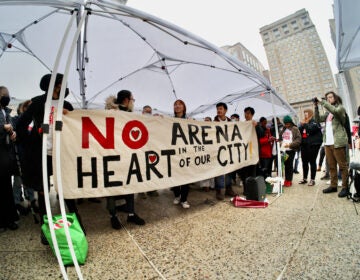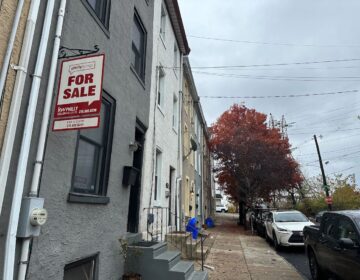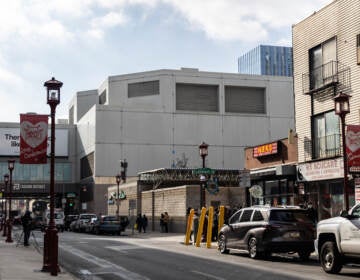Sixers’ $1.5B arena plan stokes ‘rendering wars’ across New Jersey, Delaware and Pennsylvania
State officials are offering up a buffet of graphic renderings to woo the Philadelphia 76ers in the team’s plan for a new arena.
Listen 1:12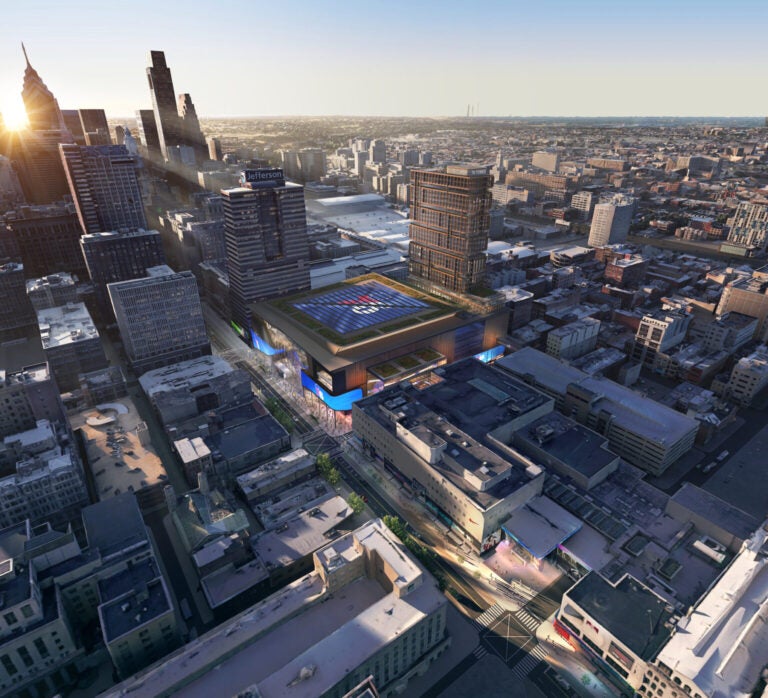
The 76ers are pitching a mixed-use development in Philadelphia's Market East neighborhood near Chinatown that would include a residential tower and retail shops. (Courtesy of 76 DevCorp)
Sixers arena: What you need to know
- The 76ers have proposed moving to a new $1.55 billion arena near Chinatown called “76 Place”
- The proposal has drawn swift condemnation, excitement, skepticism — and plenty of buzz
- Black Clergy of Philadelphia has endorsed the project, while a majority of Chinatown businesses and other community members have voiced their opposition
- Amid competing interests, the arena’s future remains uncertain
It’s no secret that the Philadelphia 76ers NBA basketball team owners have been dribbling around for a new home for several years. And the way competition is mounting among suitors, the team could score its new home anywhere in the tri-state region: Pennsylvania, New Jersey or Delaware.
Sports economists and community members argue that’s what businesses do — create a heightened interest and a bidding war among prospective locations, so they can walk away with the best incentives. The ultimate goal of sports teams is to fetch the largest economic incentives from politicians eager to bring jobs to their respective constituents.
That playbook is not a new concept for Philadelphia region sports projects – there’s plenty of past practice. Lincoln Financial Field cost $642 million to build, about $304 million of which was subsidized by the state and city coffers. The $367 million Citizens Bank Park received about $170 million in state and city subsidies. Comcast Spectacor’s Wells Fargo Center, initially known as First Union Center, had a price tag of $206 million. At the time it was built, there was $23 million in public subsidy between the city of Philadelphia and the state of Pennsylvania for infrastructure improvements, according to a Federal Reserve Bank of Kansas City study of sports project.
Now the big question is, will Philadelphia be able to keep the 76ers in the city with or without throwing in lucrative deals?
The Market Street East arena
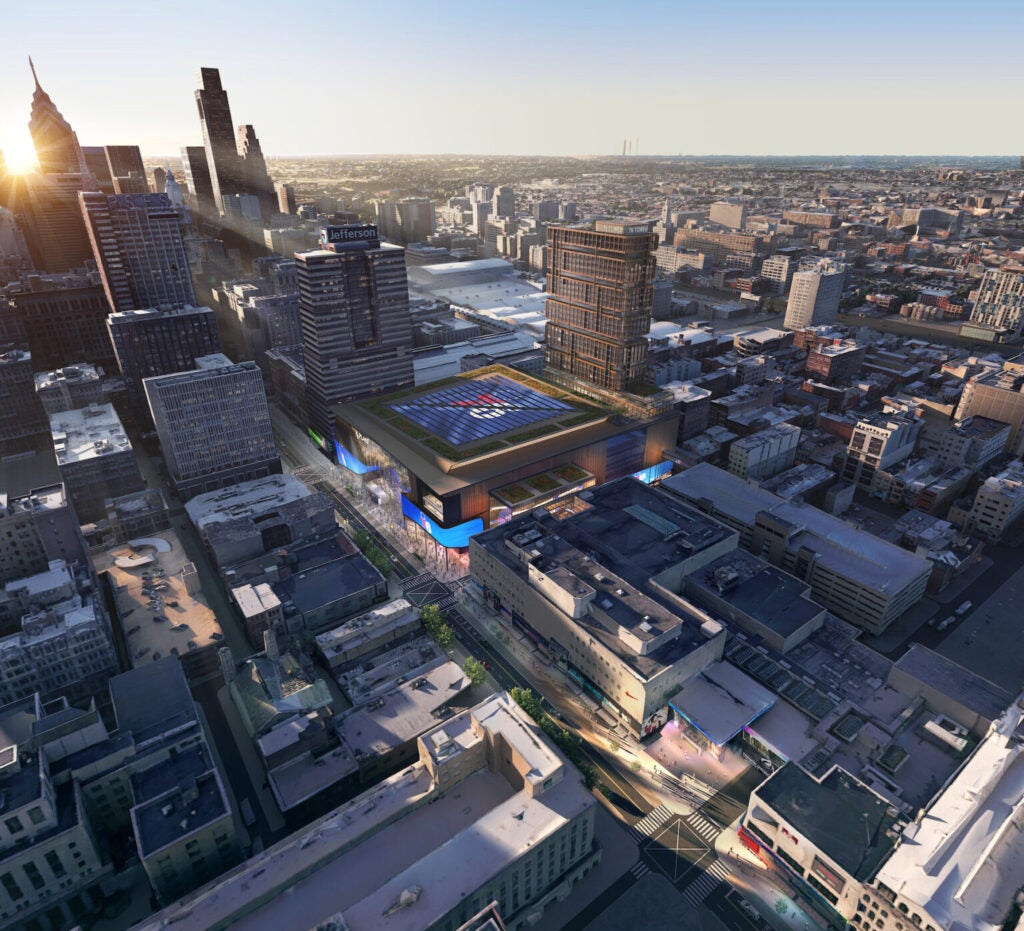
The Sixers propose building a new arena in Market East between 10th and 11th streets — replacing about one-third of the struggling Fashion District mall. The 18,500-seat facility would have ground floor retail shops and host not only sporting events, but concerts, performances and community gatherings.
The initial plan had a $1.3 billion price tag. But after a 20-story-tall residential tower was added last year, it bumped to $1.55 billion. There’s plans for nearly 400 residential units, a portion of which are supposed to be affordable.
In exchange, the Sixers are offering a $50 million community benefits agreement.
For several years, the Sixers maintained that the arena would be 100% privately funded. But in early September, the Philadelphia Inquirer reported that the Sixers want retroactive subsidies, if the Comcast Spectacor’s South Philly Sports Complex and other similar projects get economic incentives.
As of Sept. 12, Philadelphia Mayor Cherelle Parker’s administration declined to comment about any government assistance being considered.
Pennsylvania Gov. Josh Shapiro has repeatedly pushed for the state to adopt more aggressive economic incentive packages to entice the private sector and has said he’s willing to be “competitive as hell” to attract businesses and retain them. The governor’s office also did not respond to a request for comment.
About a year ago, WHYY News reached out to sports economist and Holy Cross University professor Victor Matheson about the Sixers privately funded arena proposal.
“It certainly makes no sense to put any public money into this because it doesn’t make sense to spend hundreds of millions of dollars, moving economic activity, just a few miles,” Matheson said last year. “And at this point, all you worry about is the level of disruption that may happen to existing neighborhoods, not about whether you’re really generating new economic activity.”
Matheson was skeptical about whether community benefit agreements would be much more than “giving away a bunch of tickets that they couldn’t sell.”
Save Chinatown calls foul
Community members not interested in a towering development next door to Chinatown have long protested the 76ers Market East arena choice.
“From our vantage point, [whether] this supposed move to Camden or anywhere else is a classic bullying tactic from the real estate developer playbook,” said Mohan Seshadri, executive director of Asian Pacific Islander Political Alliance, part of the Save Chinatown Coalition. “Across the country billionaire team developers are trying to push legislation through and the moment it gets tough they threaten to leave.”
Sashadri said he’s hopeful that the city of Philadelphia’s new mayor won’t agree to such a deal.
“We have every expectation that the bullying tactic from the developers is going to fall flat with [Mayor Cherelle Parker]. We’ve always maintained that public money should be spent on the public good [and] Philly needs so much investment,” he said.
Sashadri said that there’s already economic development happening in Chinatown — just north of Market East and the arena would fragment that progress from small businesses to schools, mixed-use developments and apartments — at a time when the state is trying to stitch the community back together with the I-95 cap project. He touted a Chinatown cultural center that draws interest from across the country which means visitors “staying at hotels and buying cheesesteaks.”
The Camden Sixers
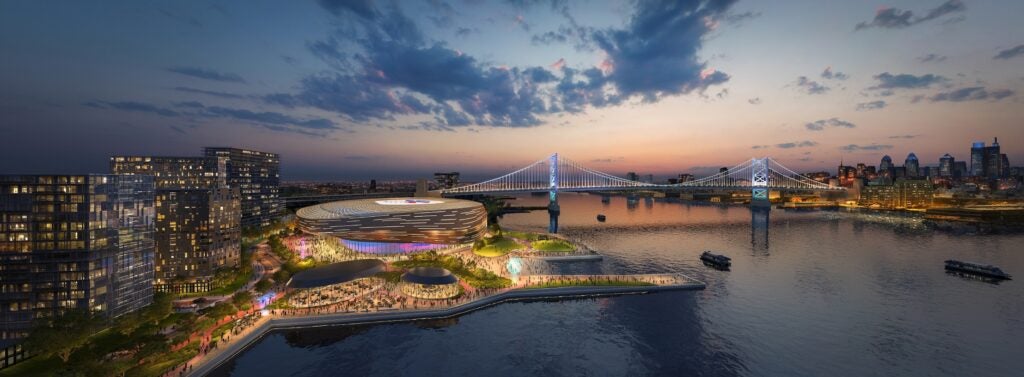
Next up: New Jersey’s bet to revitalize the Camden Delaware River waterfront.
The New Jersey Economic Development Authority and State of New Jersey pitched $800 million in economic incentives to the 76ers to redevelop the site of the former Riverfront State Prison, which was demolished in 2010.
The state agency and the Sixers declined to be interviewed.
Plans show a glimmering multipurpose indoor arena on the Camden waterfront with public outdoor space, a parking garage, residential space and mixed-used commercial development towers.
“The rendering shows the potential transformation of Camden’s waterfront at the former state prison site north of the Ben Franklin Bridge [and across the river from Philadelphia],” said Tim Sullivan, CEO of the New Jersey Economic Development Authority, in a statement. “The proposed project is more than just a state-of-the-art arena. It’s an open space, new housing, restaurants, and office space.”
The ultimate goal, Sullivan said, is that the project will “help bring new good-paying jobs to the city.”
In the state’s economic pitch for the sports arena, Sullivan touted, “when New Jersey commits to the success of a project, we deliver,” as its promise.
The state’s Aspire Program could offer two tax credit awards totaling $800 million, which would offset the cost of the arena and the parking garage, Sullivan said.
That Aspire program “would be subject to a standard Net Benefits Test ensuring that New Jersey taxpayers are more than paid back for their investment via incremental state, county and local tax revenues,” according to the pitch letter to the 76ers.
New Jersey is also offering to ask for $500 million in special purpose bonds from the state legislature to finance the project up front. The money would be repaid over the years via “fees and surcharges on tickets, concessions and parking” remitted by the team owners.
The Garden State is already gearing up for a big sports event at MetLife Stadium in East Rutherford, with the FIFA soccer World Cup final in 2026.
“The World Cup will be held here which is going to bring the world to focus on the state of New Jersey,” said Tom Bracken, president and CEO of the New Jersey State Chamber of Commerce. “Getting the 76ers to move to New Jersey [would be] very significant to boost our state’s image and perception. And that means a lot when you’re talking about trying to make the state a good place to live and work and retain businesses.”
Bracken said Camden could really benefit from a Sixers relocation.
“Camden has come a long way over the last bunch of years, going from a town that was really distressed and significantly impacted negatively and it has had a revival. There’s still work to do,” he said. “Something like this would just accelerate that momentum. The stronger you can make the urban areas of New Jersey, the better off it is for the entire state.”
Camden’s mayor Victor Carstarphen called the state’s proposal “a generational investment” in the city.
“A lot of work is being done here, infrastructure, parks, improvement, our police department,” he said. “We are home to corporate entities like Campbell Soup … to the executive headquarters of Subaru. I think we’re prime for a project like the 76ers arena. We’ve been building and building and building for a situation like this.”
There’s a $300 million plan to overhaul the Walter Rand Transportation Center downtown. Coincidentally, there’s a brand new PATCO train station near Independence Mall in Center City Philadelphia.
The team’s owners have roots in New Jersey. In 2013, 76ers owners Harris Blitzer Sports Entertainment purchased the New Jersey Devils, who play in Newark’s Prudential Center. In 2016, the company opened a 76ers practice complex in Camden.
“The governor’s full steam ahead with leading this charge. The Sixers of course have been tremendous partners with our city, just very much engaged,” Carstarphen said. “This is by no means a competitive thing with the city of Philadelphia. I have a great amount of respect for Mayor Parker and sympathize with the potential impact on Chinatown. We just have this space shovel ready.”
But, New Jersey Gov. Phil Murphy didn’t project confidence in landing the 76ers in Camden during the “Ask the Governor” show Sept. 12, despite the hefty incentive package floated by his team.
”I want to say up front, it’s not clear that we’re going to win this. The Philadelphia 76ers, they’ve been there a long time. [But] this will transform Camden,” Murphy said.
If the Sixers do choose Camden, Murphy promised there would be a community benefits agreement for that neighborhood, too.
“We deliberately went out to the community [to a] bunch of the leaders there who we’ve worked with over the years and made sure that they knew that we had their back,” Murphy said. “If we get this, this is a game changer. Generational game changer.”
In response, the Sixers said they are weighing their options as their lease is slated to expire in the coming years.
“We appreciate Governor Murphy and the NJEDA for presenting a thoughtful and compelling vision for the revitalization and economic growth of Camden, a city we are already committed to through our Training Complex,” the 76ers said in a statement. “We have worked tirelessly for the past five years to build an arena in Philadelphia and negotiations remain ongoing with city leadership regarding our proposal at Market East. The reality is we are running out of time to reach an agreement that will allow the 76ers to open our new home in time for the 2031-32 NBA season. As a result, we must take all potential options seriously, including this one.”
The Delaware Sixers
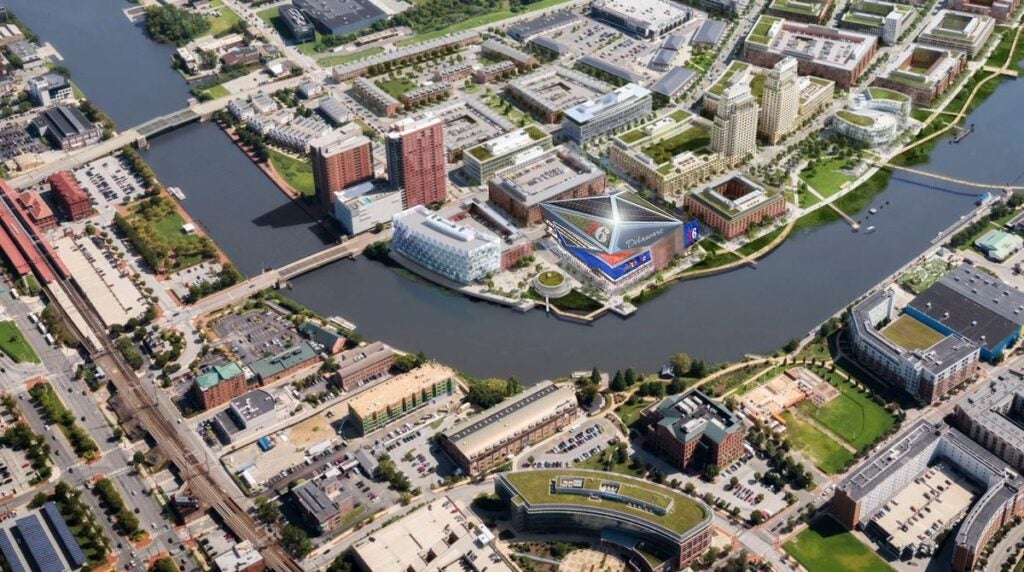
Details about the state of Delaware’s pitch for the next Sixers stadium are scant, save for a social media post in mid-August by outgoing Gov. John Carney.
Gov. Carney touted that the Sixers have a “large fan base” in the state with the “best community around” in the city of Wilmington, in addition to the state’s lack of sales tax.
Gov. Carney’s office did not respond to a request for comment. Choose Delaware, the state’s economic development arm, deferred comments to the governor’s office, citing that the agency is not involved in such a pitch.
The Comcast Sixers
In late August, representatives of Comcast Spectacor approached the Washington Square West Civic Association board about a new NBA basketball arena for redevelopment on Market Street, east of City Hall.
The board agreed to a closed-door meeting, according to the Washington Square West Civic Association’s president Tami Sortman.
As of Sept. 6, the civic association’s board has endorsed neither the Comcast vision nor the Sixers’ arena proposal.
Comcast Spectacor pitched its presentation to the association board with several graphic renderings. Its vision includes a biomedical hub inside the less popular section of the Fashion District.
“Our hope is that the 76ers will remain in South Philadelphia as a partner in the Wells Fargo Center,” said Dan Hilferty, chairman and CEO of Comcast Spectacor, in a statement.

As it stands, the Fashion District is owned and operated by Macerich, a Santa Monica, California-based real estate business. Macerich told WHYY News that the company is “very excited” to be working with the Sixers on its new arena.
The ‘Zombie’ sports stadium
As of this week, when reached by phone about the Sixers changes and counter proposals — Matheson, the sports economist, was most concerned about the trajectory of the project.
“There’s no chance at all that the 76ers [will] leave the Philadelphia metro area. It’s a giant population hub and it’s got deeply connected roots to the 76ers,” he said. “So we’re seeing the [76ers] play Pennsylvania against New Jersey and against Delaware and, again, this is a super common ploy. We’re seeing it in D.C. right now with the [Washington] Commander’s NFL stadium.”
Matheson described the practice as an “extortion game” that’s “one the biggest tools that sports teams can usually use against cities to extract subsidies is gone because there’s no credible threat to relocate them to, for example, Kansas City.”
As for whether a Comcast Spectacor sports complex in South Philly, Wilmington or Camden could reasonably coincide with a Market East 76ers arena, he was doubtful.
“It’s a little harder to make that math pencil out correctly when you’re going to be having two arenas literally next door to each other,” he said. “And it’s next door whether it gets built in Chinatown or Camden or in the current [South Philly] arena district. Philly is not likely to be getting a huge number of new events with a second arena.”

Overall, he cautioned taking too much stock in the validity of graphic renderings in the lobbying effort.
“Throwing out a rendered picture, that can be as little as 30 seconds on ChatGPT with AI. But I will say that having deals that look like they’re going through and then they don’t then they come back, it’s pretty common,” he said. “Basically every arena is a zombie arena, they never die. Any proposed arena, especially one with public subsidies, comes back from the dead until there is dirt being turned or a solid new lease for the 76ers at their existing place. Every deal is still alive and they’re almost impossible to kill.”

Get daily updates from WHYY News!
WHYY is your source for fact-based, in-depth journalism and information. As a nonprofit organization, we rely on financial support from readers like you. Please give today.



